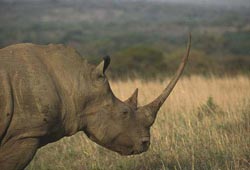Poaching threatens savannah ecosystems

Rhino<br>Swedish University of Agricultural Sciences <br>
The white rhino (Ceratotherium simum), and other megaherbivores, are key drivers of ecosystem functioning because they´re not controlled by predation.
A new study by Joris Cromsigt and Mariska te Beest, published in Journal of Ecology, highlights the role of the white rhino in the savannah ecosystems.
Earlier empirical studies on the ecosystem impact of megaherbivores are strongly biased to African elephant with very little contemporary evidence for other megaherbivore species. Cromsigt and te Beest quantifies how rhino recolonized Kruger National Park (KNP) following their re-introduction in the 1960s to create a unique ‘recolonization experiment’ and tests how this megagrazer is affecting the structure of savanna grasslands.
The researchers identified landscapes that rhino recolonized long time ago versus landscapes that were recolonized more recently. The assumption was that time since colonization represents a proxy for extent of rhino impact. Grassland heterogeneity on 40 transects covering a total of 30 kilometer were recorded. Short grass cover was clearly higher in the high rhino impact than low rhino impact landscape. Moreover, they encountered about 20 times more grazing lawns, a specific grassland community, in the high rhino impact landscape.
The conclusion is that white rhinoceros may have started to change the structure and composition of KNP’s savanna grasslands. The amount of short grass in savannas has important consequences for other species, but also components of ecosystem functioning such as fire regimes. The results highlight that this poaching crisis not only affects the species but threatens the potentially key role of this megaherbivore as a driver of savannah functioning.
Restoration of a megaherbivore: landscape-level impacts of white rhinoceros in Kruger National Park, South Africa
The article is published online in Journal of Ecology 12 feb 2014,
DOI: 10.1111/1365-2745.12218 http://onlinelibrary.wiley.com/doi/10.1111/1365-2745.12218/abstract
Contact information: Assistant Professor Joris Cromsigt, Swedish University of Agricultural Sciences, Department of Wildlife, Fish and Environmental Studies, joris.cromsigt@slu.se
+27 727547596
Pressofficer: Olof Bergvall, +46 90-786 82 11, olof.bergvall@slu.se
Weitere Informationen:
http://www.slu.se/en/departments/wildlife-fish-environmental-studies/staff/list/cromsigt-joris/
Joris Cromsigt personal webpage
Media Contact
More Information:
http://www.vr.seAll latest news from the category: Ecology, The Environment and Conservation
This complex theme deals primarily with interactions between organisms and the environmental factors that impact them, but to a greater extent between individual inanimate environmental factors.
innovations-report offers informative reports and articles on topics such as climate protection, landscape conservation, ecological systems, wildlife and nature parks and ecosystem efficiency and balance.
Newest articles

Silicon Carbide Innovation Alliance to drive industrial-scale semiconductor work
Known for its ability to withstand extreme environments and high voltages, silicon carbide (SiC) is a semiconducting material made up of silicon and carbon atoms arranged into crystals that is…

New SPECT/CT technique shows impressive biomarker identification
…offers increased access for prostate cancer patients. A novel SPECT/CT acquisition method can accurately detect radiopharmaceutical biodistribution in a convenient manner for prostate cancer patients, opening the door for more…

How 3D printers can give robots a soft touch
Soft skin coverings and touch sensors have emerged as a promising feature for robots that are both safer and more intuitive for human interaction, but they are expensive and difficult…





















